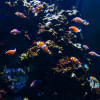An old tale is being unfolded once more. The authorities have laid out plans for the Rangpur Zoo of Rangpur district and the Bangladesh National Zoo at the capital's Mirpur. Talks are being held to remodel both the zoos not as places of captivity but as sanctuaries, where animals can roam around freely. The zoos are to become a safe haven where the concept of 'viewing' animals shifts to 'encountering' them.
This announcement has been met with great enthusiasm and curiosity from animal lovers and rights activists alike. But what should be our expectations from this initiative? Will the age-old concept of animals being displayed for entertainment finally be scrapped for good?
Director of Bangladesh National Zoo, Mohammad Rafiqul Islam Talukder, informed The Daily Star that discussions are being held to modernise and remodel the establishments. "We have submitted our proposal, but nothing has been finalised yet. Nevertheless, we are hopeful for a positive outcome and if everything goes well, we will start the proceeding sometime around July this year," he stated.
The remodelling project of Rangpur Zoo and National Zoo is envisioned to embody the principles of modern zoo design, focusing on animal welfare and conservation. The aim is to transition from traditional zoo practices to creating habitats that closely mimic the animals' natural environments.
Rakibul Haque Amil, Founder and Chairperson of the People for Animal Welfare (PAW) Foundation, echoes this sentiment, emphasising the need for change: "Activists like us have many times raised our voices for the welfare of animals – especially, the ones who are confined in a zoo. Caged animals develop a certain type of stereotyping behaviour because they have repetitive routines. So, the new decision may give these animals some sort of relief."
The primary expectation of the remodelling project is the overhaul of animal enclosures, providing more greenery and complex structures to encourage natural behaviours. The new designs are expected to be spacious and tailored to the specific needs of each species, significantly improving their quality of life.
Amil further highlights the negative impact of external factors on zoo animals, saying, "The blaring noise coming from outside, people's unkind behaviour towards these animals, and the overall condition of the zoo do not contribute to the betterment of these animals, rather these are harmful to them." He suggests that the new plan should address these concerns by working closely with conservationists or wildlife specialists to create spaces that closely resemble the animals' natural habitats.
"Why do we need zoos?" asked Saria Saguaro Ahmed, a painter, pastry chef, and partner at Pat a Pet café. "We have internet or other resources now if we want to get to know an animal. Back then, there was no internet or any other modern technologies. So, we needed zoos or similar establishments to research and continue conservational work. We should be thinking futuristically and think about the values we want our children to learn," she suggests.
That said, the revamped zoos can serve as hubs for environmental education and awareness. Interactive exhibits, educational programs, and conservation workshops will engage visitors of all ages, fostering a deeper understanding and appreciation for wildlife.
Joyeeta Trisha, a photographer and passionate animal lover, expressed her perspective on the importance of creating naturalistic habitats within zoos. "Now and then, we hear the news of animals dying in the zoo, and this is extremely sad. Animals should live in their natural habitats, not in cages. So, I am happy to hear the authorities have decided to change the scenario, and the initiative will hopefully foster a deeper connection and respect for animals among visitors."
The renovation of the zoos presents a unique opportunity to redefine the relationship between humans and wildlife. By focusing on the well-being of the animals, conservation, education, and community engagement, these zoos can become a beacon of hope for wildlife preservation.
As we anticipate the completion of this remodelling project, our expectations are high, but so is our optimism. The Rangpur Zoo and Bangladesh National Zoo can set new standards for animal care, conservation, and public engagement. This transformation promises not just an improved zoo experience but a step forward in our collective journey towards a more ethical and sustainable coexistence with the natural world.








Comments